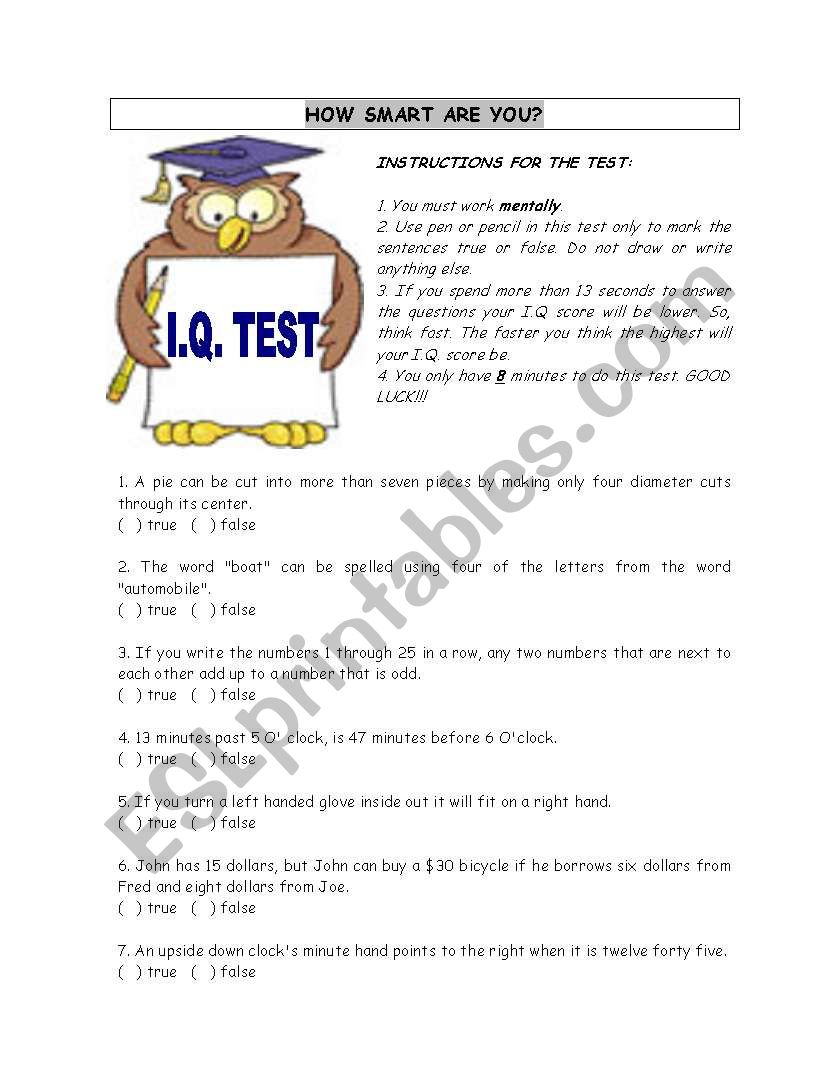

People with DS follow the same developmental stages of language acquisition, although these are rarely complete (Rondal, 2009, p. Such delay in language production is also reflected in the more predominant use of gestures by DS children than typically developing children (TDC) (Kim & Ko, 2002). It is referred to as delayed instead of deficient ability as people with DS produce their first utterances or words later than their peers. Language is one of the common developmental disabilities in individuals with DS. Only the translocation type is inherited (Wajuihian, 2016, p. Down syndrome has three types: trisomy 21 (found in 95% of people with DS), translocation (4%) and mosaic (1% - 2%).
ARABIC IQ TEST WITH ANSWERS PDF GENERATOR
This extra copy of chromosome 21 is the generator of abnormalities and structural and functional anomalies in the body's systems (Wajuihian, 2016, p. This error produces an extra copy of chromosome 21, resulting in 47 chromosomes instead of the normal 46. Keywords: Down syndrome dual grammatical number inflection Jordanian Arabic morphology plural singular.ĭown syndrome (DS), also known as trisomy 21, is the most commonly identified genetic disorder, and the most frequent chromosomal defect in live-birth infants as a consequence of non-disjunction, an error in cell division. Linguistic teaching and training of children with DS (involving families, caregivers and educators) should start from childhood and continue to adulthood to improve their use of dual and plural numbers. The non-recognition cases of the proper number category significantly mark language delay in participants with DS.ĬONCLUSION: The study concluded that inflection for grammatical number is evidently delayed in individuals with DS. Hence, sensitivity to the correct number option increases with age although children and young adults with DS do not reach adult-like performance. The cumulative results statistically prove the influence of age on the correct use of grammatical number, in favour of the older two groups (total F = 29.865, at the level of significance P = 0.000), with a higher arithmetic mean of all categories (AM: KG2 = 9.00, school = 15.10, VT = 16.25). Results were in line with other research on morphological markers in individuals with DS (e.g. Intriguingly, the dual form is the most difficult plural pattern because it was the least frequently used pattern in everyday language. RESULTS: The singular form was the most used by all age groups (83.3%), followed by the plural (27%) the most delayed was dual (10.3%). Post hoc comparisons (guided by the Scheffe test) were calculated for the cumulative results of the scale as a whole to examine the difference in the arithmetic mean between the three groups. The one-way analysis of variance was used to trace the impact of age on the correct performance of number. Proficiency percentage in using the correct number in correlation with age was calculated adopting Jia's (2003) composite score of proficiency. Tokens were classified into correctly used, incorrectly used or not recognised.
ARABIC IQ TEST WITH ANSWERS PDF FREE
The participants' data were collected from a picture elicitation task and free speech, and the answers were recorded using a smartphone. The participants were divided into three groups: KG2 (7.1-12.5 years old), school (13.10-17.6) and vocational training (18.3-27.3). METHODS: The study involved 60 monolingual Arabic children and young adults with DS, 30 males and 30 females, enrolled at the Nazik Al Hariri Welfare Centre for Special Education, Amman. The work also examines the correlation between age and the correct production of singular, dual and plural numbers OBJECTIVES: This study investigates the accuracy of grammatical number inflection produced by Jordanian Arabic-speaking children and young adults with DS. Grammatical number inflection in Arabic-speaking children and young adults with Down syndromeīassil Mashaqba Haneen Abu Sa'aleek Anas Huneety Sabri Al-Shboulĭepartment of English Language and Literature, Faculty of Arts, The Hashemite University, Zarqa, JordanīACKGROUND: Individuals with Down syndrome (DS) have more difficulties with the structural aspects of language, including morphology (concatenation and non-concatenation) and syntax (word order and grammatical/concord rules), than with other language components (e.g.


 0 kommentar(er)
0 kommentar(er)
